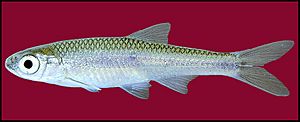Texas shiner facts for kids
The Texas shiner (Notropis amabilis) is a type of ray-finned fish that lives in rivers and streams. It's part of the Notropis family. You can find this fish in the Colorado River and Rio Grande areas, stretching from Texas into northeastern Mexico. It also lives in the Rio Salado and Rio San Juan systems in Mexico, and down to the lower Pecos River in Texas.
Quick facts for kids Texas shiner |
|
|---|---|
 |
|
| from San Marcos River, Texas | |
| Conservation status | |
| Scientific classification | |
| Synonyms | |
|
Contents
Where Texas Shiners Live
Texas shiners usually live in springs and the small streams that feed into larger rivers. They can be very common in these areas. Sometimes, you might find a few in bigger streams too.
These fish prefer clear water with sandy, gravelly, or rocky bottoms. They often swim in groups in streams where the water moves at a medium speed. You can find them in the deeper parts of pools, especially below areas where the water flows quickly. They also like fast-moving water near gravel bars.
Texas shiners are often seen in turbulent water below small dams or road crossings. They really like currents and are most common in swift-moving water. They often swim near the surface in swirling water caused by things in the stream.
If Texas shiners live in the same area as other fish like Cyprinella lutrensis and C. venusta, they tend to choose spots with faster currents. They also stick together in schools more than the other two species do.
Texas Shiner Biology
Reproduction and Spawning
In Texas, Texas shiners lay their eggs from February through September. Young fish, less than 20 millimeters (about 0.79 inches) long, have been found from mid-April to mid-December. This suggests that spawning starts around late March and continues until mid-November. In Mexico, they seem to lay eggs for a long time, from early spring into summer.
Female Texas shiners can produce multiple groups of eggs throughout the spawning season. In October, some females had mature eggs. By January, about a quarter of females had developing eggs. Mature eggs first appeared in February in some females. In April, most females (75%) had mature eggs. The peak time for reproduction was in August and September. A female can lay between 102 and 286 eggs, with an average of about 174 eggs.
What Texas Shiners Eat
Texas shiners are mostly insect eaters. They feed mainly on aquatic insects that float in the water. Common foods include water insects (71%) and algae (61%). Among the water insects, mayflies were the most common, followed by caddisflies, flies/midges, beetles, and moths/butterflies. They sometimes eat insects that fall from land into the water. They have also been seen feeding near the water's surface.
Texas Shiner Population Status
As of 2017, the number of Texas shiners is generally stable and secure. This means their populations are not currently in danger.
Studies have shown that Texas shiner populations were stable or even growing in several streams. They were found to be common or frequent in many rivers, including the Colorado, Guadalupe, San Antonio, Nueces, Pecos, and Rio Grande.
However, Texas shiners have not been found recently in a few places. For example, they might be gone from urbanized areas like Barton Creek. This could be due to dams, pollution, or other fish that are not native to the area. Despite these few local issues, the overall number of Texas shiners is still considered secure.
- Texas shiner on FishBase
See also
 In Spanish: Notropis amabilis para niños
In Spanish: Notropis amabilis para niños


